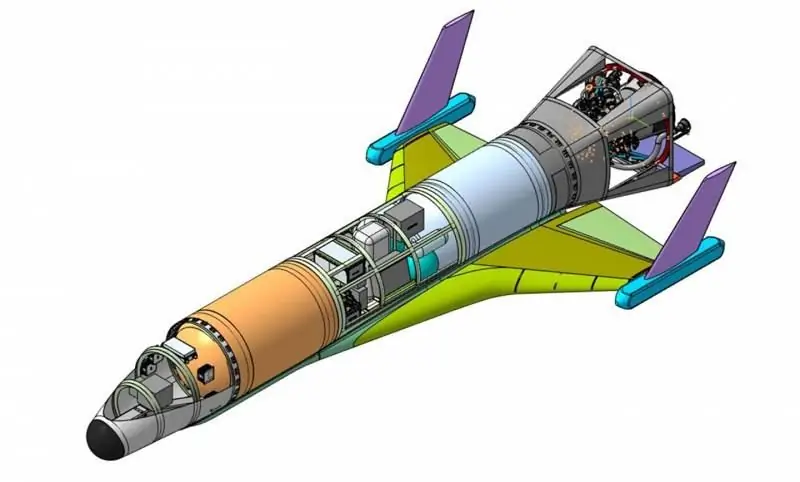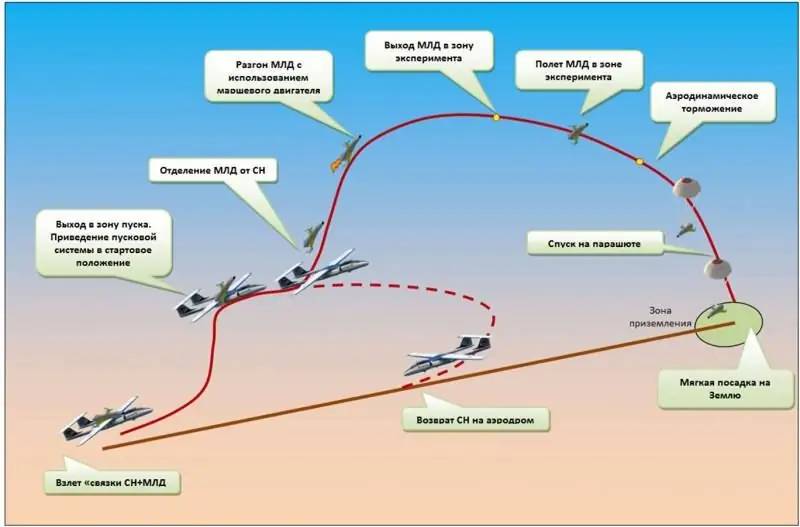- Author Matthew Elmers [email protected].
- Public 2023-12-16 21:49.
- Last modified 2025-01-24 09:17.
In our country, the development of a new project of a reusable spacecraft has started. The main part of the research work has already been carried out, which makes it possible to move to a new stage of design. The finished spacecraft, which is expected to appear in the next decade, will be able to solve commercial problems and carry out a large number of re-flights. The new project is being developed by the private company ISON, which is part of the Skolkovo Foundation's Advanced Manufacturing Technologies Cluster.
According to the available information, the ISON company has been working on the creation of a promising spacecraft for several years. So, over the past two years, she was engaged in the theoretical study of the project and the conduct of the necessary research. In particular, a model of new technology was tested in a wind tunnel. The information obtained allows you to move on to the technical design of a new prototype.

At the moment, the main goal of the so far unnamed project is the creation of the so-called. reusable modifiable scaled flight demonstrator (MLD). This product will be a scaled-down model of a full-fledged aircraft intended for the first stage of flight design tests. During the MLD tests, specialists will collect new information, with the help of which the project will be fine-tuned. Then the development of a full-fledged spacecraft starts.
On January 30, the Skolkovo Foundation published a new message on the progress of the work of the ISON company and its successes. Based on the results of previous work on the topic of reusable spacecraft, a private company received a perpetual license from the State Corporation Roscosmos, which gives it the right to create rocket and space technology. In addition, the company has passed ISO 9001: 2015 quality management certification. These events allow the ISON specialists to continue their work.
The company's plans for the coming years have already been announced. She intends to complete the development of the project and carry out the preparation of production. Then there will be mock-ups intended for ground testing. Later, a prototype model of the MLD type will be built. He will have to perform five test flights. All these checks will be carried out no later than 2023. The timing of the completion of the project and the start of operation of the equipment has not yet been specified. Probably, we are talking about the middle and second half of the twenties.
The financial features of the project are known. At the early stages of development, the Project-Tekhnika corporation allocated 25 million rubles to ISON JSC. Another 30 million has been received from the Skolkovo Foundation in the form of a grant. Further work, which will result in finished products, requires another 280 million rubles. According to current plans, part of this money will be provided by Skolkovo, while the rest will be received from other co-investors.
***
According to the development company, the new project provides for the creation of a multipurpose spacecraft with a number of characteristic capabilities. So, it is planned to provide the ability to solve problems both in airspace and in space. It is claimed that the device from "ISON" will be the first model in the world with such functions. The chosen launch method using a carrier aircraft is expected to allow the spacecraft to operate anywhere in the world and provide significant launch savings. All this should simplify and reduce the cost of the development of suborbital near-Earth space.
The ISON company has already disclosed the expected characteristics of the future spacecraft and the main features of the promising complex as a whole. The so far unnamed project proposes the construction of the so-called. an aerospace system consisting of a carrier aircraft and an aircraft-type orbiter. The carrier will have to lift the orbital plane into the air and put it on a given trajectory. After detachment, the spacecraft, using its own power plant, will have to fly according to a given program.
Probably, a full-fledged spacecraft will be able to perform aerodynamic braking and land "like an airplane", but the experienced MLD will have other functions. The flight demonstrator of the new program will land with a parachute. Apparently, this will simplify the testing without prejudice to their scientific results.
The spacecraft of the proposed appearance may be of interest to various structures. The official resources of the Skolkovo Foundation in the section “main consumers of the product” include the state corporation Roscosmos, the United Rocket and Space Corporation and the Ministry of Defense. However, so far we are talking only about potential customers. The project is still in its early stages, which imposes certain limitations on its commercial potential.
***
On February 4, RIA Novosti published new data on the ISON project, namely a couple of demonstration slides. The first image shows a diagram of the MLD prototype aircraft and reveals some details of this project, and the second demonstrates the features of the flight during future tests. The concept of the aerospace system and the methods of its operation are well known to specialists and the public, therefore, the image of the future flight demonstrator is of greatest interest.
From the published images, it follows that the project of the "ISON" company provides for the construction of a "space plane" of the type traditional for this technique. It is proposed to use a low-wing scheme with a small wing span and keels on the tips. The project provides for entering orbit using its own power plant, which accordingly affected the appearance and design of the vehicle. At the same time, MLD is designed as an unmanned aerial vehicle, and this excludes the use of a cockpit, but imposes requirements on instrumentation.
According to the published image, the MLD should have a large elongation fuselage, having a circular cross-section for most of its length. In this case, a rounded nose cone and an expanding tail engine compartment are provided. There are two instrument compartments in the nose and in the center of the fuselage. The space between them, as well as behind the central compartment, is given to a pair of tanks for fuel components. The tail accommodates the propulsion system. Unfortunately, the exact list of components and assemblies has not yet been published, and only individual devices are mentioned.
The orbital aircraft receives a trapezoidal wing of small span and aspect ratio, equipped with developed forward flares. The trailing edge of the wing is equipped with elevons of the largest possible span. Large and long wingtips are provided, serving as the bases for two arrow-shaped keels. Behind the engine compartment, below, there is an additional plane. Probably, it should serve as an elevator.
It is proposed to use the 14D30 liquid-propellant rocket engine, borrowed from the Breeze upper stage, as a power plant. This product has a dry weight of 95 kg and a length of 1, 15 m with a diameter of not more than 950 mm. The engine uses a fuel pair "NDMG-AT", the control gas is nitrogen. The thrust is determined at 2000 kgf, the specific impulse is 328.6 s. The maximum time of one switch-on is 2500 s. Such characteristics will be sufficient for the proposed flight demonstrator.
The dimensions and weight of the future prototype remain unknown. In the diagram showing the flight profile, MLD is depicted "on the back" of the M-55 Geophysics high-altitude aircraft, and this could allow one to estimate the size and proportions. However, it is unknown whether the M-55 will be used in the upcoming tests. In addition, it is unclear whether the authors of the scheme tried to comply with the real proportions of the technique.

It should be noted that so far we are talking only about a scaled flight demonstrator, while the main features and characteristics of a full-fledged spacecraft remain unknown. Apparently, the spacecraft will be similar to the expected MLD and no major design changes are planned. Nevertheless, it is not yet possible to speak with confidence on this topic, and any scenario is possible.
However, the development company is already ready to name the approximate characteristics of the finished aircraft. This product is expected to be able to perform suborbital or full-fledged orbital flights. In the first case, the height of the trajectory will reach 160 km. The speed on the suborbital trajectory will reach M = 7. The maximum attainable orbital altitude is determined at 500 km. The estimated resource of the apparatus is 50 flights.
A promising reusable device will be lifted into the air using a carrier aircraft. It is not known which aircraft will provide flights. Lack of information about the dimensions and weight of the device, in turn, interferes with estimates and forecasts. Probably, these features of a promising project will be revealed in the future.
In the framework of flights with different profiles, the spacecraft will be able to perform a wide range of tasks. First of all, it is proposed to use it as a platform for conducting experiments and a "vehicle". In particular, the reusable spacecraft will be able to launch various satellites into low orbits with permissible dimensions and weight. The development company notes that its spacecraft will not have a military purpose and will not be able to become a carrier of strike systems.
***
It should be recalled that the project of a reusable spacecraft from JSC "ISON" is not the first domestic development of this class. In the past, similar projects were repeatedly proposed, but none of them reached full-fledged practical implementation and operation. The successful completion of past projects was hampered by various financial, organizational and other factors. At present, a new attempt is being made to create a reusable aerospace system, and it is not yet clear how it will end.
The domestic private company "ISON" has already carried out a number of necessary studies and is now making plans to develop and test a scaled flight demonstrator, which should open the way for a full-size model with all the desired functions. If the project does not encounter unforeseen difficulties or other problems, a fundamentally new spacecraft may appear in our country already in 2023.






